
The Wii is a home video game console developed and marketed by Nintendo. It was released on November 19, 2006, in North America and in December 2006 for most other regions of the world. It is Nintendo's fifth major home game console, following the GameCube and is a seventh-generation console alongside Microsoft's Xbox 360 and Sony's PlayStation 3.

Hogan's Alley is a light gun shooter video game developed and published by Nintendo. It was released for the Family Computer in 1984 and then the arcade Nintendo VS. System and Nintendo Entertainment System in 1985. It was one of the first hit video games to use a light gun as an input device, along with Nintendo's Duck Hunt (1984). The game presents players with "cardboard cut-outs" of gangsters and innocent civilians. The player must shoot the gangs and spare the innocent people. It was a major arcade hit in the United States, where it was the highest-grossing arcade system game of 1985, as well as Europe.

1080° Snowboarding is a snowboarding video game developed and published by Nintendo for the Nintendo 64 in 1998. In the game, the player controls one of five snowboarders from a third-person perspective, using a combination of buttons to jump and perform tricks over eight levels.

The Legend of Zelda: Twilight Princess is a 2006 action-adventure game developed and published by Nintendo for the GameCube and Wii home video game consoles. Originally planned for release exclusively on the GameCube in November 2005, Twilight Princess was delayed by Nintendo to allow its developers to refine the game, add more content, and port it to the Wii. The Wii version was a launch game in North America in November 2006, and in Japan, Europe, and Australia the following month. The GameCube version was also released in December 2006 as the final first-party game for the console.

Nintendo optical discs are physical media used to distribute video games on three of Nintendo's consoles that followed the Nintendo 64. These are the GameCube Game Disc, Wii Optical Disc, and Wii U Optical Disc. The physical size of a GameCube Game Disc is that of a miniDVD; the Wii is based on DVD format, and Wii U Optical Discs are based on Blu-ray format. To maintain backward compatibility between generations of game consoles, GameCube discs are compatible with the first model of the Wii, and Wii Optical Discs are compatible with the Wii U. A burst cutting area is located at the inner ring of the disc surface. All official discs and their formats were manufactured and developed by Panasonic.
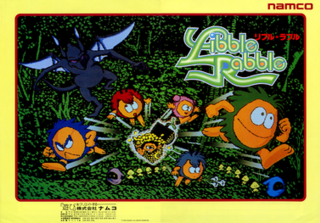
Libble Rabble is a 1983 puzzle arcade game developed and published in Japan by Namco. The player is tasked with using two colored arrows, Libble and Rabble, to wrap them around pegs and surround small creatures known as Mushlins to "harvest" them under a time limit. The player can also uncover treasure chests that will have the player searching the stage for items in order to access a special bonus stage. It ran on the Namco Libble Rabble hardware, one of the only games to do so.
Nintendo European Research & Development (NERD) is a French subsidiary for Nintendo, located in Paris, which develops software technologies and middleware for Nintendo platforms. This includes retro console emulators, patented video codecs, and DRM technology.
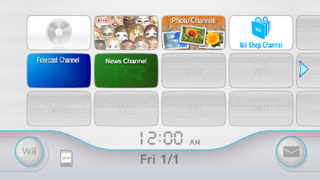
The Wii Menu is the graphical shell of the Wii and Wii U game console, as part of the Wii system software. It has four pages, each with a 4:3 grid, and each displaying the current time and date. Available applications, known as "channels", are displayed and can be navigated using the pointer capability of the Wii Remote. The grid is customizable; users can move channels among the menu's 48 customizable slots by pressing and holding the B button while hovering over the channel the user wanted to move, then pressing and holding the A button and moving the channel. By pressing the plus and minus buttons on the Wii Remote users can scroll across accessing empty slots.

The Japanese multinational consumer electronics company Nintendo has developed seven home video game consoles and multiple portable consoles for use with external media, as well as dedicated consoles and other hardware for their consoles. As of September 30, 2021, in addition to Nintendo Switch, Nintendo has sold over 863.07 million hardware units.

Excitebots: Trick Racing, known in Japan as Excite Mou Machine, is a racing video game published by Nintendo for the Wii video game console. Developed by Monster Games, it is the fourth game in the Excite series and the sequel to Excite Truck (2006). Excitebots was released on April 20, 2009 in North America. Excitebots features animal-themed robot vehicles and short minigames during racing, such as pie throwing, bowling and soccer. The game could be bought packaged with or without the Wii Wheel, similar to Mario Kart Wii.
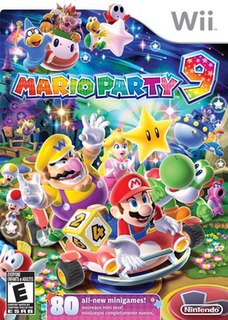
Mario Party 9 is a party video game developed by NDcube and published by Nintendo for the Wii. The ninth main installment in the Mario Party series, it was announced at E3 2011 and released in Europe, North America, and Australia in March 2012, followed by Japan a month later. It was the first game in the series not to be developed by Hudson Soft, which was acquired and dissolved by Konami on March 1, 2012. Instead, development was taken over by Nintendo studio NDCube. This was also the final Mario game to be released on the Wii.

Mario is a media franchise, produced and published by video game company Nintendo, created by Japanese game designer Shigeru Miyamoto and starring the fictional Italian plumber Mario. It is primarily a video game franchise, but has extended to other forms of media, including television series, comic books, a 1993 feature film, an upcoming 2023 animated film and theme park attractions. The series' first installment was 1983's Mario Bros., although Mario had made his first appearance in 1981's Donkey Kong, and had already been featured in several games of the Donkey Kong and Game & Watch series. The Mario games have been developed by a variety of developers including Nintendo, Hudson Soft, and AlphaDream. Most Mario games have been released exclusively for Nintendo's various video game consoles and handhelds, from the third generation onward.
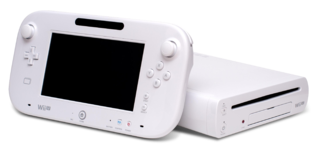
The Wii U is a home video game console developed by Nintendo as the successor to the Wii. Released in late 2012, it is the first eighth-generation video game console and competed with Microsoft's Xbox One and Sony's PlayStation 4.

Mario & Sonic at the London 2012 Olympic Games is a 2011 crossover sports and party game developed by Sega Japan. It was published by Nintendo in Japan and Korea and by Sega elsewhere. As the third instalment in the Mario & Sonic series, it was released on the Wii on 15 November 2011 in North America, 18 November 2011 in Europe, and 26 December 2011 in Japan. It was also released for the Nintendo 3DS in February 2012. Mario & Sonic is the official video game of the 2012 Summer Olympics and is licensed by the International Olympic Committee through exclusive licensee International Sports Multimedia. The game is the only Wii title to come in a yellow keep case.
Pilotwings is a series of flight simulation video games beginning with the 1990 video game Pilotwings and most recently Pilotwings Resort in 2011. One of Nintendo's franchises, the series was released on the Super Nintendo Entertainment System, Nintendo 64, and Nintendo 3DS.

The Game & Watch brand is a series of handheld electronic games developed, manufactured, released, and marketed by Nintendo from 1980 to 1991. Created by game designer Gunpei Yokoi, the product derived its name from it featuring a single game as well as a clock on an LCD screen. The models from 1981 onwards featured an alarm in addition.
The Nintendo Network is Nintendo's online service which provides online functionality for the Nintendo 3DS and Wii U systems and their compatible games. Announced on January 26, 2012 at an investors' conference, it is Nintendo's second online service after Nintendo Wi-Fi Connection. Former president of Nintendo Satoru Iwata said, "Unlike Nintendo Wi-Fi Connection, which has been focused upon specific functionalities and concepts, we are aiming to establish a platform where various services available through the network for our consumers shall be connected via Nintendo Network service so that the company can make comprehensive proposals to consumers."

Nintendo Land is a party video game developed and published by Nintendo as a pack-in launch title for the Wii U home video game console in 2012. The game was first announced at E3 2012 during Nintendo's press conference.

The Wii U system software is the official firmware version and operating system for Nintendo's Wii U home video game console. Nintendo maintains the Wii U's systemwide features and applications by offering system software updates via the Internet. Updates are optional to each console owner, but may be required in order to retain interoperability with Nintendo's online services. Each update is cumulative, including all changes from previous updates.
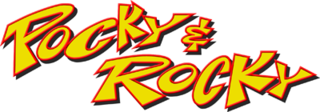
Pocky & Rocky, known in Japan as Kiki Kaikai, is a scrolling shooter video game series originating with the 1986 arcade game Kiki Kaikai by Taito. It was then adapted into a series of home console games entitled Pocky & Rocky in the West mainly developed and published by Natsume. The games follow the adventures of a young Shinto shrine maiden, Pocky, and her tanuki companion, Rocky, as well as other allies, as they fight against monsters.

















